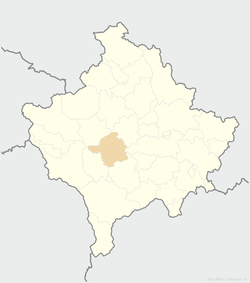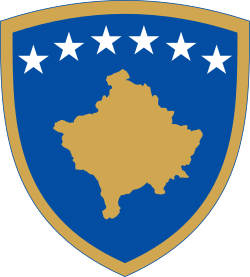Mališevo
Mališevo (Serbian Cyrillic: Малишево) or Malisheva (Albanian: Malishevë), is a town and municipality located in the Prizren District of Kosovo[lower-alpha 1]. According to the 2011 census, the town of Mališevo has 3,395 inhabitants, while the municipality has 54,613 inhabitants.
Mališevo | |
|---|---|
Town and municipality | |
 Emblem | |
 Location of the municipality of Mališevo within Kosovo | |
| Coordinates: 42°28′58″N 20°44′45″E | |
| Country | Kosovo[lower-alpha 1] |
| District | District of Prizren |
| Government | |
| • Mayor | Reqip Begaj |
| • Municipal | 306 km2 (118 sq mi) |
| Elevation | 538 m (1,765 ft) |
| Population (2011) | |
| • Urban | 3,395 |
| • Municipal | 54,613 |
| • Municipal density | 180/km2 (460/sq mi) |
| Time zone | UTC+1 (CET) |
| • Summer (DST) | UTC+2 (CEST) |
| Postal code | 24000 |
| Area code(s) | +381 |
| Car plates | 07 |
| Website | kk |
History
The population of the town has historically been predominantly ethnic Albanian. The town was largely destroyed by Serbian forces in 1998. Town residents only returned following the 1998 withdrawal of Serbian paramilitary police and military, in response to international pressures.[1]
The town became a stronghold for the ethnically Albanian Kosovo Liberation Army during the Kosovo War in 1999. The United Nations Interim Administration Mission in Kosovo (UNMIK) formally re-established the municipality of Mališevo in July 2000. During the war, a number of atrocities were committed by both Albanian and Yugoslav forces. One such incident occurred in Mališevo, the execution of no fewer than seven Serbian men, named the Mališevo Massacre. The UN-run Office on Missing Persons and Forensics began the excavations at the site in May 2005.
Economy
There is one gold mine operating on the territory of Mališevo - Trpeza.
Demographics
| Year | Pop. | ±% p.a. |
|---|---|---|
| 2011 | 54,613 | — |
| 2016 est. | 57,301 | +0.97% |
| Source: Division of Kosovo | ||
According to the last official census done in 2011, the city of Mališevo has a population of 54,613 inhabitants. The municipality has ethnic Kosovo Albanians majority (54,501; 99.8%). Based on the population estimates from the Kosovo Agency of Statistics in 2016, the municipality has 58,282 inhabitants.
See also
- Subdivisions of Kosovo
Notes and references
Notes:
- Kosovo is the subject of a territorial dispute between the Republic of Kosovo and the Republic of Serbia. The Republic of Kosovo unilaterally declared independence on 17 February 2008, but Serbia continues to claim it as part of its own sovereign territory. The two governments began to normalise relations in 2013, as part of the 2013 Brussels Agreement. Kosovo is currently recognized as an independent state by 97 out of the 193 United Nations member states. In total, 112 UN member states recognized Kosovo at some point, of which 15 later withdrew their recognition.
References
- Julius Strauss, "Albanian refugees nervously return to their Kosovo homes as Serbian troops pull out". Daily Telegraph via the National Post, October 28, 1998, p. A12.
